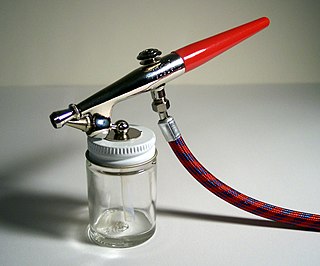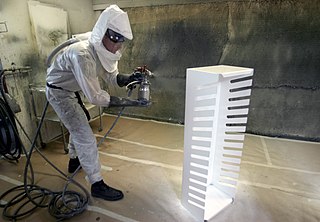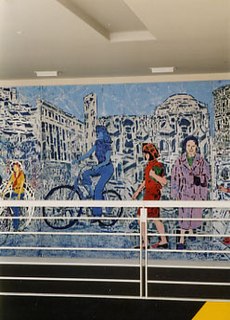
Wilhelm Heinrich Otto Dix was a German painter and printmaker, noted for his ruthless and harshly realistic depictions of German society during the Weimar Republic and the brutality of war. Along with George Grosz and Max Beckmann, he is widely considered one of the most important artists of the Neue Sachlichkeit.

Sir Lawrence Alma-Tadema, was a Dutch painter who later settled in the United Kingdom and became a denizen there. Born in Dronryp, the Netherlands, and trained at the Royal Academy of Antwerp, Belgium, he settled in London, England in 1870 and spent the rest of his life there. A classical-subject painter, he became famous for his depictions of the luxury and decadence of the Roman Empire, with languorous figures set in fabulous marbled interiors or against a backdrop of dazzling blue Mediterranean Sea and sky. Alma-Tadema was considered one of the most popular Victorian painters. Though admired during his lifetime for his draftsmanship and depictions of Classical antiquity, his work fell into disrepute after his death, and only since the 1960s has it been re-evaluated for its importance within nineteenth-century British art.

An airbrush is a small, air-operated tool that atomizes and sprays various media, most often paint but also ink and dye, and foundation. Spray painting developed from the airbrush and is considered to employ a type of airbrush.

Spray painting is a painting technique in which a device sprays coating material through the air onto a surface. The most common types employ compressed gas—usually air—to atomize and direct the paint particles.

Joaquin Alberto Vargas y Chávez was a Peruvian-American painter of pin-up girls. He is often considered one of the most famous of the pin-up artists. Numerous Vargas paintings have sold and continue to sell for hundreds of thousands of dollars.

George Brown Petty IV was an American pin-up artist. His pin-up art appeared primarily in Esquire and Fawcett Publications's True but was also in calendars marketed by Esquire, True and Ridgid Tool Company. Petty's Esquire gatefolds originated and popularized the magazine device of centerfold spreads. Reproductions of his work, known as "Petty Girls," were widely rendered by military artists as nose art decorating warplanes during the Second World War, including the Memphis Belle.

Color field painting is a style of abstract painting that emerged in New York City during the 1940s and 1950s. It was inspired by European modernism and closely related to abstract expressionism, while many of its notable early proponents were among the pioneering abstract expressionists. Color field is characterized primarily by large fields of flat, solid color spread across or stained into the canvas creating areas of unbroken surface and a flat picture plane. The movement places less emphasis on gesture, brushstrokes and action in favor of an overall consistency of form and process. In color field painting "color is freed from objective context and becomes the subject in itself."

Irwin Caplan, nicknamed Cap, was an American illustrator, painter, designer and cartoonist, best known as the creator of The Saturday Evening Post cartoon series, Famous Last Words, which led to newspaper syndication of the feature in 1956.
Allan Capron Houser or Haozous was a Chiricahua Apache sculptor, painter and book illustrator born in Oklahoma. He was one of the most renowned Native American painters and Modernist sculptors of the 20th century.
Howard Arkley was an Australian artist, born in Melbourne, known for his airbrushed paintings of houses, architecture and suburbia. His parents were Australian, and had British ancestry.
John Salt was an English artist, whose greatly detailed paintings from the late 1960s onwards made him one of the pioneers of the photorealist school.
Alexandre Hogue was an American artist active from the 1930s through the 1960s. He was a realist painter associated with the Dallas Nine; the majority of his works focus on Southwestern United States and South Central United States landscapes during the Dust Bowl.
Kay WalkingStick is a Native American landscape artist and a member of the Cherokee Nation. Her later landscape paintings, executed in oil paint on wood panels often include patterns based on Southwest American Indian rugs, pottery, and other artworks.
Han Hsiang-ning is a Taiwanese-American artist. He emigrated to New York from Taiwan in 1967. He joined the O.K. Harris Works of Art from 1971 until 1984. Han has participated in many prominent museum exhibitions. He often uses spray painting and paints photo-realistic street scenes.

Airbrush makeup is makeup sprayed onto the skin using an airbrush machine instead of being applied with sponges, brushes, fingers, or other methods. A typical airbrush system uses a compressor to create airflow through a hose connected to a trigger-controlled spray painting gun. The airbrush pressure can be adjusted to apply various types of makeup, such as lighter, heavier, or more detailed styles. Airbrushes are used in film, theater, bridal makeup, and sunless tanning. Airbrush systems designed for personal, in-home use are usually smaller and work at a lower pressure than systems used in professional applications.

Franklin Gritts, also known as Oau Nah Jusah, or "They Have Returned", was a Keetoowah Cherokee artist best known for his contributions to the "Golden Era" of Native American art, both as a teacher and an artist.

Scott Williams is an American artist best known for paintings made using stencils. He began working with stencils in the early 1980s, painting on walls, cars and the found paper and objects that accumulated in his studio. He has painted many murals in San Francisco and was dubbed by artist/writer Aaron Noble The Stencil Godfather of the Mission, where stencil graffiti is common. Williams has painted numerous murals in San Francisco, both indoors and out, including Armadillo's on Fillmore Street, Amoeba Records, Clarion Alley, Leather Tongue video, The Chamelleon bar, DNA Lounge, Burger Joint, Pedal Revolution, and The Lab. The preponderance of his work in the Mission and his ability to go back and forth from street to studio has led some people to see him as a forerunner of the Mission school, which coalesced 10 years after he began working in the neighborhood. Working outside the mainstream, Williams exhibited at alternative spaces throughout the 80s and 90s including Show and Tell Gallery, Altarpiece at the Offensive, Bibliomancy, the Adobe Bookstore and Southern Exposure. As curatorial awareness of Williams grew, he was invited to exhibit at Yerba Buena Center for the Arts, and the San Francisco Art Institute.
Robert Redbird Sr. was a Native American artist who painted in order to preserve and communicate the Kiowa culture. He is known primarily for his blanket-wrapped Southern Plains figures and depiction of Kiowa folklore. Redbird worked in several media but is most well known for having accomplished his works with an airbrush. Oklahoma Governor Brad Henry declared June 7, 2003, as "Robert Redbird Day" to celebrate the artist's many creative and humanitarian achievements.
Bert Seabourn is an American expressionist painter, known for his stylized and nonrepresentational neo-expressionist artist. In his early career, he published comic book art and realistic pieces, as well as commercial art. He has won multiple awards for his artworks. An alumnus of Oklahoma City University, the school awarded him the honorary degree of Doctor of Humane Letters in 1997.
Donald Vann is a Cherokee artist from Oklahoma known for painting detailed landscapes with Native American subjects. Vann conveys the traditions and culture of his tribe through soft lines and colors. He has exhibited his work throughout the U.S. and abroad, winning numerous awards for his mystical paintings.










